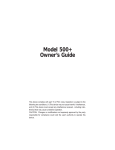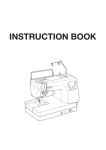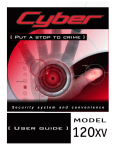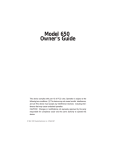Download Table of Contents - Net
Transcript
Table of Contents Warranty............................................................................. 2 What is Included ................................................................ 3 Standard Configuration ..................................................... 4 Using your System ............................................................ Arming ........................................................................ Armed while Driving ............ ...................................... Disarming ................................................................... High Security Disarm ................................................. Disarming without a transmitter .................................. Silent Mode .. ............................................................. Panic Mode ................................................................. Valet Mode................................................................... 5 5 6 6 6 7 7 7 8 Nuisance Prevention Circuitry 8 ......................................... Diagnostics ......................................................................... 9 Arming Diagnostics ............ ......................................... 9 Disarming Diagnostics ................................................. 10 Table of Zones .................................................................... 10 Code Hopping Explained .................................................. 11 Programming Options ........ ................................................ 11 Glossary of Terms........ ....................................................... 13 Security & Convenience Expansions... ................................ 14 5 Years Limited Lifetime Warranty: Model 260 HF Directed Electronics, Inc. , promises to the original purchaser to repair or replace with a comparable reconditioned model any electronic control module which proves to be defective in workmanship or material under normal use during 5 years, AS LONG AS THE SYSTEM WAS SOLD, INSTALLED, AND SERVICES BY AN AUTHORIZED DEI DEALER,(LIMITED LIFETIME WARRANTY COVERS THE SYSTEM FOR THE ORIGINAL OWNER OF THE ORIGINAL VEHICLE IN WHICH THE SYSTEM WAS INSTALLED). After 5 years, a flat cost will be charge to repair the product . If warranty service is necessary you must have a clear copy of your sales receipt containing all the informations mentionned below. All components other than the unit, including without limitation the siren, the remote transmitters and the associated sensors and accessories, carry a one-year warranty from the date of purchase. This warranty is void if the product has been damaged by accident, unreasonable use, neglect, impoper service or other cases not arising out of defects in materials or fabrication.This warranty is non transferable and does not apply to any unit that has been modified or used in a manner contrary to its intended purpose and does not cover batteries. This warranty does not cover labor costs for the removal, diagnosis, troubleshooting, removal and reinstallation of the unit. For service on an out-of-warranty product, a flat rate fee by model will be charged. Contact your authorized dealer to obtain the service charge for your unit. IMPORTANT DEI security systems, including this unit, are deterrents against possible theft. DEI is not offering a guarantee or insurance against vandalism, damage or theft of the automobile, its parts or contents; and hereby expressly disclaims any liability whatsoever, including without limitation, liability for theft, damage and / or vandalism. The product warranty is automatically void if its date code or serial number is defaced , missing, or altered. Any defective unit must be returned to Directed Electronics Inc., postage prepaid by an authorized dealer. Make sure you have all af the following information from your VIPER® dealer: A clear copy of the sales receipt, showing the following: • Date of purchase • Your full name and address • Authorized dealer’s company name and address • Type of alarm installed • Year, make, model and color of the automobile • Automobile license number • Vehicle identification number • Security options installed on automobile • Installation receipts What is Included • • • • • • The control unit A pair of two-button transmitters A Stinger® Doubleguard® dual-stage shock / impact sensor The Revenger® Soft Chirp® six-tone programmable siren The red status LED indicator A push-button Valet® switch CONGRATULATION on the purchase of your state-of-the-art vehicle security system. By carefully reading this guide prior to using your system, you will maximize the use of this system and its features. You ca print additional or replacement copies of this manual by accessing the DEI® Internet website at www.dei.com. THE SYSTEM REQUIRES NO SPECIFIC MAINTENANCE. Your remote control is powered by a miniature 12V battery, type GP23A, that will last approximately one year under normal use. When the battery weakens, operating range will be reduced and the LED on the remote will light dim. It is also necessary to keep your proof of purchase.. -3- Standard Configuration LED Arm Disarm Panic Silent Mode Auxiliary Output Button I The arm, disarm and panic functions, are usually controlled by button I. Button II Silent ModeTM and an optional auxiliary function, such as trunk release, are usually controlled by button II. Silent Mode works by pressing button II for less than one second. Trunk release requires you to press button II for 1.5 seconds. -4- Using your System Arming You can turn on, or arm, the system by pressing Button I of your transmitter for one second. When the system arms, you will hear a short siren sound,or chirp, and see the parking lights flash once. If the vehicle’s power door locks are controled by the system, the doors will lock. While the system is armed, the Status LED will flash about twice a second, showing that the system is actively protecting your vehicle. If you hear a second chirp after arming and see the Status LED flashes in groups, see Diagnostics section. This extra chirp is called Bypass Notification. The system also can be programmed to arm itself automatically (called passive arming). If the system is programmed for passive arming, it will automatically arm 30 seconds after the ignition is turned off and the system“sees” you leave the vehicle by opening and closing a door. Whenever the system is in its 30 second passive-arming countdown, the status led will flash twice as fast as it does when the system is armed. NOTE: If any protected entry point (such as a door or a switchprotected trunk or hood) is open, the system will not passively arm, unless forced passive arming is progarmmed on. (See Programming Options section). Additionally, each time a sensor is triggered during the arming countdown, the 30 second countdown starts over.) When armed, your vehicle is protected in the following ways: • Light impacts will trigger the Warn Away® signal. When triggered, the siren will chirp and the parking lights will flash for a fey seconds. •Heavy impacts will trigger the system. The trigger sequence is 30 seconds of constant siren and flashing parking lights. -5- • If a door is opened, the system will immediately start chirping the siren and flashing the parking lights. Three seconds later, the siren output changes to a continuous blast. This progressive reponse gives you time to disarm the system with your transmitter if you inadvertently open the door while the system is armed, while still providing instant response (even if the door is immediately closed). • Turning on the ighition key will trip the same two-stage reponse as opening a door. Armed While Driving Your system can be armed while driving the vehicle! Simply press Button I on your transmitter while the vehicle is running. The system will chirp once and then once more to indicate that the ignition is on. The system will not respond to any input except the door triggers and the starter kill relay (if installed) will not be activated. Once you have reached your destination, the system must be disarmed by pressing Button I on the transmitter once more. The siren will chirp twice and the LED will stop flashing. If you do not disarm the system, it will trigger when the any door is opened to exit the vehicle. Disarming To turn off, or disarm the system, press Button I again. You will hear two chirps, and te parking lights will flash twice. If power locks are controlled by the system, the doors will unlock. If the siren chirps either four or five times when disarming, see Diagnostics section.This is called Tamper Alert. High Security Disarm Your system includes a High Security Disarm feature. During the triggered sequence, using the transmitter to disarm it will only stop the triggered sequence (the siren will stop and the parking lights will stop flashing). However, the system will remain armed and the doors will stay locked. This is extremely useful if you must stop the system from sounding, but are unable to check the vehicule visually. The trigger will stop, but the vehicle will remain protected. To disarm with the transmitter during a trigger, press Button I on your trasmitter. The siren will stop sounding. Next press Button I once more and the system will chirp four or five times (reporting the trigger) and disarm. -6- Disarming Without a Transmitter This feature allows you to disarm the system without the transmitter should it be lost, damaged or disabled. In order to disarm without a transmitter, you must have the vehicle’s ignition key and know where the Valet button is. Be sure to check with the installer for the location of the Valet button. Turn on the ignition. Push the Valet switch within 15 seconds. The system should now disarm. If it does not, you may have waited too long, so turn the ignition off and on and try again. Silent ModeTM To temporarily turn off the arm of disarm chirps, use Silent ModeTM. Simply press Button II briefly before arming or disarming, and the confirmation chirp(s) will be eliminated for that one operation only. If you want the arm/disarm chirps turned off permanently, your dealer can do this for you. NOTE: The Warn Away® response to lighter impact is bypassed if the system is armed using Silent Mode. This ensures that no chirps will be emittted by the siren in an area you want chirp-free. The system is still fully able to trigger. Only the Warn Away response is defeated. Panic Mode If you are threatened in or near your vehicle, you can attract attention by triggering the system with you transmitter! Just press Button I for 1.5 seconds, and you will enter Panic Mode. The siren will sound and the parking lights will flash for 30 seconds. To stop Panic Mode at any time, press Button I on the transmitter again. -7- Valet® Mode You can prevent your system from automatically arming and triggering by using Valet Mode. This is very useful when washing the vehicle or having it serviced. In Valet Mode, the system will not arm, even with the transmitter, but all convenience functions (door locks, trunk release, etc.) will work normally. To enter or exit Valet Mode with the Valet switch: Turn ignition to “run” position, then turn to “off” position. Press and release the Valet switch within 10 seconds. The Status LED will light steady if you have entered Valet Mode, and it will go out if you exited Valet Mode. Using Remote Valet Mode as you enter or exit the vehicle: • Open any door. • Press Button I (or the arm/disarm button). • Press Button II (or the function 2 button). • Press Button I again. The Status LED will light steady if you have entered Valet Mode, and it will go out if you exited Valet Mode. Nuisance Prevention® Circuitry Your system has DEI’s Nuisance Prevention® Circuitry (NPC TM ). It prevents annoying repetitive trigger sequences due to faulty door pin switches or environmental conditions such as thunder, jackhammers, airport noise, etc. Here’s how it works: Let’s say the alarm triggers three times. Each time, the same sensor or switch is triggering the alarm. The three triggers are within 60 minutes of each other. NPCTM (Nuisance Prevention® Circuitry) will interpret this pattern of triggers as false alarms. After the third trigger, NPC ignores, or bypasses, that sensor or switch (along with any other sensors or switches sharing the same zone). -8- If the bypassed sensor tries to trigger the system while it is being bypassed, the 60 minute bypass period will start over. This ensures that a sensor that a sensor that continuously triggers will remain bypassed. Doors are covered by NPC differently; If the alarm is triggered by an open door for three full cycles (one-and-one-half minutes), the doors will be bypassed until the trigger ceases. NOTE: Arming and disarming the system does not reset this function! The only ways to reset a bypassed zone are for it to remain untriggered for 60 minutes, or to turn on the ignition. If testing your system, it is important to remember that the NPC programming can cause zones to be bypassed and seem to stop working. If five chirps are heard when disarming, NPC has been engaged. If you wish to clear the NPC memory, turn the ignition on. Diagnostics The Microprocessor at the heart of your system is constantlly monitoring all of the switches and sensors connected to it. It detects any faulty switches and sensors and prevents them from disabling the entire system. The microprocessor will also record and report any triggers that occured during your absence. Arming Diagnostics If the system is armed with an input active (door open, sensor triggering, etc.) the unit will chirp once when arming and then one more time a few seconds later. This is called Bypass Notification. NOTE: Bypass Notification will not occur when using Silent Mode or if chirps have been programmed OFF. The system will ignore the input that was active when it was armed until it goes away. Three seconds later it will monitor that input normally. For example, if your car has interior light exit delay, and you arm the system before the interior light goes out, you may get Bypass Notification. Once the light goes out, however, the doors are monitored normally. -9- Disarming Diagnostics Extra disarm chirps are the Tamper Alert. If four chirps are heard when disarming, the system was triggered so many times that Nuisance Prevention® Circuitry has bypassed that zone. In either case, the Status LED will indicate which zone was involved (see Table of Zones section). The system will retain this information in its memory, and chirp four of five times each time it is disarmed, until the next time the ighition key is turned on. Table of Zones The zone number is the number of LED flashes used by the system to identify that input. the standard input assignments are listed below, along with spaces to write in any optional sensors or switches you have had installed. NOTE: If the Warn Away® response is triggered, the LED will not report it. ZONE (# of LED FLASHES) DESCRIPTION 1 Instant trigger of optional sensors 2 A heavier impact trigger from the shock sensor 3 Door switch circuit 4 Ignition -10- DEALER-INSTALLED NED Code-Hopping™ EXPLAI LAIN The receiver and transmitters each use a mathematical formula called an algorith to change their code each time the transmitter is used. This technology has been developed to increase the security of the unit. The contol unit knows what the next codes should be. This helps to keep the trasmitter “in synch” with the control unit even if you use the remote control out of range of the vehicle. However, if the transmitter has been pressed many times out of range of the vehicle,or the battery has been removed, it may get out of synch with th control unit and fail to operate the system. To re-synch the remote control simply press the arm/disarm button of the remote control several times within range of the vehicle. The alarm will automatically re-synch and respond to the transmitters normally. Programming Options Programming options control what your system does during normal operation, and require little or no additional parts. However, some may require additional installation labor. The factory settings are in bold. • Active arming (only with the transmitter) or passive arming (automatic arming 30 seconds after the last door is closed). • Arming/disarming confirmation chirps on or off. • Passive door locking (with passive arming) or active door locking (only when arming with the transmitter). this feature only works if passive arming has been selected for step one. • The ignition-switch-contolled door-locking feature on or off. With this feature on, the doors will lock 3 seconds after the key is turned on, and unlock when the key is turned off. Note: If the door is open when the ignition is turned on, the doors will not lock -11- • Panic mode enabled/disabled with the ignition on. (Some states have laws against siren capability in a moving vehicle). • Automatic Engine Disable (AED) on or off. This feature deters theft of the vehicle, whether or not the alarm is armed. If AED is programmed on, the starter of the vehicle will be disabled 30 seconds after the ignition is turned off. The LED will flash slowly (one-half its normal armed rate) to indicate the AED arming cycle. 30 seconds later, the starter of the vehicle will be disabled. To start the car, you will need to arm the car with the remote and then disarm it with the remote. You can also disarm the AED feature by turning the ignition on and pressing the Valet button once. AED is also disabled when in Valet mode. NOTE: This feature will only function if the Failsafe starter kill relay has been installed. • Forced passive arming on or off. If your system is programmed to passively arm and this feature has been programmed on, the system will passively arm after one hour, even if a protected entry has been left open. If a door has accidentally been left ajar when leaving the vehicle, forced passive arming ensures that the system will arm in one hour. NOTE: When forced passive arming occurs, the entry point that has been left open, and anything connected to the same zone, is bypassed and cannot trigger the system. The remaining inputs to the system are fully operational. • Siren tones and chirp volume. The output of the Revenger® Soft Chirp® siren consists of six different tones in sequence. Any of these tones can be eliminated by your dealer, resulting in a unique, easily identifiable siren sound. The siren chirps can be either full volume or 6 decibels quieter than the full alarm blast. -12- Glossary of Terms Control Unit: The “brain” of your system. Usually hidden underneath the dash area of the vehicle. It houses the microprocessor which monitors your vehicle and controls all of the alarm's functions. Failsafe® Starter Kill (optional): An automatic switch controlled by the security system which prevents the vehicle’s starter from cranking whenever the system is armed. The vehicle is never prevented from cranking when the system is disarmed, in Valet mode, or should the starter kill switch itself fail. Your system is ready for this feature, however installation may require additional labor. Input: A physical connection to the system. An input can be provided by a sensor, pinswitch or to existing systems in the vehicle, such as ignition or courtesy lights. LED: A red light mounted somewhere in the vehicle. It is used to indicate the status of your system. It is also used to report triggers and faults in the system or sensors. Shock Sensor: This system is packaged with a Doubleguard® Shock Sensor. This sensor is mounted in the vehicle and is designed to pick up impacts to the vehicle or glass. Siren: Noise generating device usually installed in the engine compartment of the vehicle. It is responsible for generating the “chirps” you hear, as well as the six tones you hear while the alarm is triggered. Transmitter: Hand-held, remote control which operates the various functions of your system. Trigger or triggered response: This is what happens when the alarm “goes off” or “trips.” The triggered response of your system consists of 30 seconds of siren sounding and parking light flashing. Valet® Switch: A small push button switch mounted somewhere inside the vehicle. It is used to override the alarm when a transmitter is lost or damaged, or to enter Valet mode. Warn Away® Response: Lighter impacts to the vehicle will generate the WarnAway response. It consists of several seconds of siren chirps and parking light flashes. Zone: A zone is a separate input that the alarm can recognize as unique. Each input to the system is connected to a particular zone. Often two or more inputs may share the same zone. -13- Security & Convenience Expansions Here we have listed only some of the many expansion options available for use with your system. Please consult your dealer for a complete list of all the options available to you. Field Disturbance Sensor: An invisible dome of coverage is established by the 508D “radar” sensor. Your system can react to any intrusions into this field with the triggered sequence. Backup Battery: The 520T keeps the system armed, triggers the alarm and keeps the starter kill active if main battery power is disconnected. Electronic Hood Lock: This prevents the vehicle’s hood from being opened whenever the system is in alarm mode, keeping thieves away from the system’s siren, the battery connections, or other components under the hood. Audio Sensor: Metal on glass, glass cracking, or breaking glass produce distinctive acoustic signatures. The 506T audio sensor uses a microphone to pick up sounds, and then analyze them with proprietary acoustic software to determine if the glass has been struck. Power Trunk Release: The auxiliary output of the system can be used to operate a factory power release for the vehicle’s trunk or hatch. (An optional relay may be required.) If the factory release is not power-activated, DEI's 522T trunk-release solenoid can often be added. Power Locks: This system offers lock outputs that can control some manufacturers' power door lock systems. For other systems, additional parts may be required. Valet® Start System: For the ultimate in convenience, the Valet Start System can start your vehicle, monitor engine functions, and power your climate control system with a push of a button! Over-rev protection, openhood lockout, brake-pedal shutdown, and automatic timer shutdown are all included. (Only for automatic-transmission, fuel-injected gasoline vehicles). Power Window Control: Automatic power window control is provided with the 529T or 530T systems. These can operate power windows, roll them up automatically when the system is armed, and roll them down when the auxiliary output button is pressed. The 530T also provides one touch switch operation. -14-































